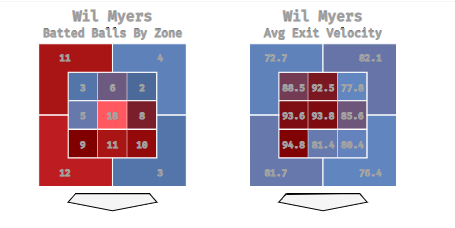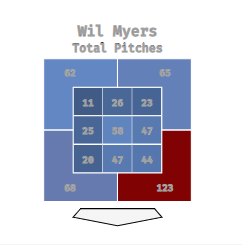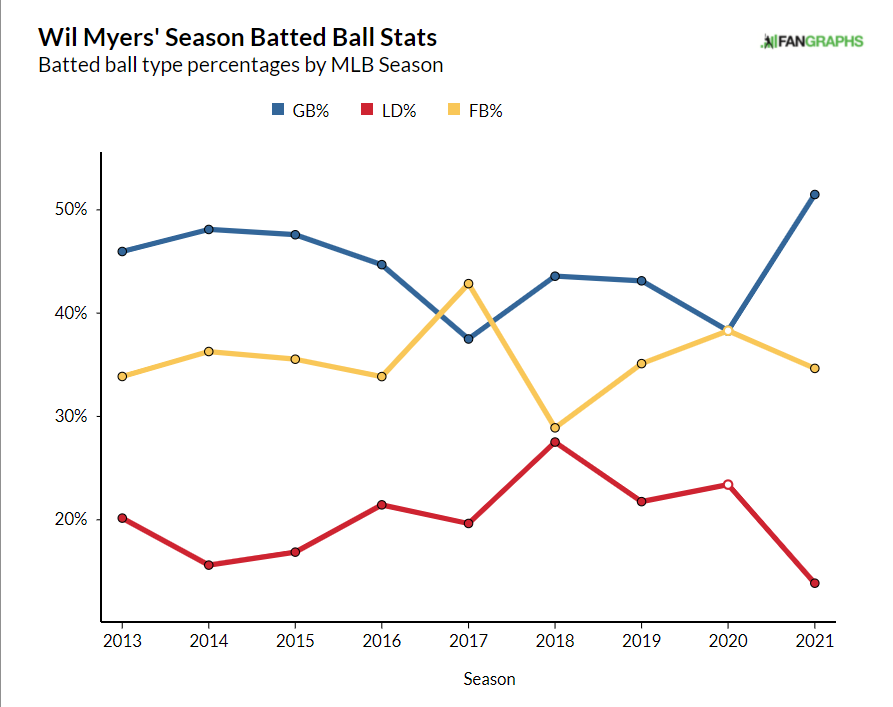Last year, Wil Myers made a swing change that broke his three season long streak of being just a league-average hitter. In his 218 PA last season, he hit .288/.353/.430 with 15 home runs and a 154 wRC+. His .318 ISO was a career high by a wide margin. Myers finished in the 93rd percentile in barrel rate, wOBA, and xwOBA. He also finished in the 95th percentile in xSLG. All in all, Myers swing change resulted in a career year. But this season it’s been a different story. He’s hitting as of late—bolstering his wRC+ up to 115—but the peripherals of Myers’s season have been drastically different. He’s gone from making some of the best contact a year ago, to making bottom-of-the-league kind of contact.
Average exit velocity, as a statistic, isn’t necessarily everything. There’s more than one way to be a good hitter, but the easiest way to give your batted balls the best chance for success is to hit them hard! I typically shy away from using average exit velocity when discussing a hitter, because the stat has a shortcoming from clumping weakly hit balls into the average, but in Myers’s case the difference between his 2021 and 2020 seasons is so drastic that an average can get the point across. Take a look at his rolling chart.

After a season where he posted a career high average exit velocity of 91 mph, Myers’ batted balls are averaging an exit velocity of 85.8 mph. This low average exit velocity places Myers in the seventh percentile. By hard hit rate, Myers lands in the 42nd percentile. After hitting a ball hard 45.8% of the time last year, Myers is finding hard contact just 39.2% of the time—a new career low. There are other factors at play, but Myers’s inability to hit the ball hard seems to be the main contributor to his underwhelming season. He’s in the 36th percentile by xwOBA, 22nd percentile by xBA, and 39th percentile by xSLG, while his barrel rate has stepped back from 14.8% to 8.8%.
Take a look at these two zone graphics of Myers this season (courtesy of Baseball Savant).

As we see by the zone chart on the left, the majority of Myers’ batted balls come from pitches that are inside off the plate—which is another issue since those pitches don’t look to be strikes—or pitches that are low and away to him. But when we take his average exit velocity in those same zones, we see that the zones Myers is making the most contact are also the zones where he is making some of his weakest contact. On inside pitches (including those off the plate), Myers holds an 84.1 mph average exit velocity, .340 xBA, .586 xSLG, and .385 xwOBA. Those numbers are still good, but they are big step back from his 2020 season, where he crushed those pitches with a .362 xBA, .632 xSLG, .422 xwOBA, and 89.1 mph average exit velocity. We expect a pull-hitter like Myers to fare well in his hot spots, but he isn’t faring well enough to make up for his lack of production in his cold spots. And where are his cold spots? The zones he is getting pitched to the most: middle-away.

Pitchers are throwing away from Myers more than any other portion of the strike zone, but specifically targeting zone 14—the low and away zone. Last season Myers held a .433 xwOBA, .352 xBA, and .683 xSLG on pitches in the outer third of the zone. He crushed them. But this season, he holds a .220 xwOBA, .226 xBA, and .270 xSLG. His average exit velocity in those zones is 81.5 mph, nearly 3 mph lower than last year. We should remember that this is an average, so it doesn’t tell us the full story, but when we can pair it with his drastically worsened expected stats, we can conclude that at least part of the problem is his weak exit velocities.
Exit velocity issues are not the only thing striking Myers at the plate. Like I’ve mentioned twice, there’s another underlying issue that, when paired with weak hit balls, makes for a disastrous combination. That issue, of course, is a climbing ground ball rate.

Myers has seen a huge increase in ground balls, hitting a ground ball 50% of the time, an 11.3% increase over last season’s ground ball rate. And while his grounders are increasing, his line drive rate is taking a nose dive. The 31.7% line drive rate Myers delivered in 2020 was a career high, but a year later Myers is looking at a new career low line drive rate of 18.6%. His average launch angle has dropped from 13.4 degrees to 5.6 degrees and his sweet spot rate has went from 40.8% to 29.4%. This further supports what we can already tell. Myers is hitting balls into the ground while inconsistently finding the barrel.
Not all is bad for Myers. Like mentioned earlier, he still has a 115 wRC+. So although it may not be all deserved, he’s an above-average hitter at this point. He his also posting a career high walk rate, putting him in the 75th percentile. However, he still whiffs in the 40th percentile, strikes out in the 52nd percentile, and chases in the 63rd percentile. So whether or not the plate discipline is a legit improvement is a question for another day. For now, Myers worries me. If he can’t find the hard hitting line drive ability he displayed last season, it’s probably just a matter of time until his luck runs thin.
(Photo by Dustin Bradford/Icon Sportswire)
